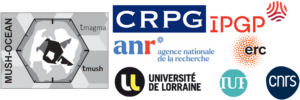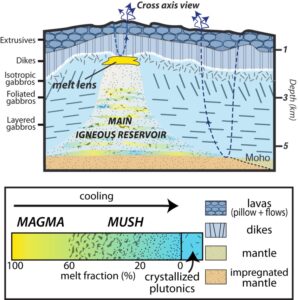Funded by the European Research Council (ERC)

A 3-year PhD position is available at the University de Lorraine (Nancy, France) in igneous petrology to study the igneous processing at stake during lower oceanic crust formation and evolution (starting date: ~September 2025). This postdoctoral position will be hosted in Dr Lydéric France group at CRPG in the frame of Pr Satish Singh (IPGP) ERC MohoLAB project, and of the collaborative MUSH-OCEAN ANR project. Applicants should submit by May 21st 2025, a cover letter, a CV, and (optional) up to 3 letters of recommendation (to: lyderic.france@univ-lorraine.fr).
Almost 2/3 of Earth’s surface is covered by oceanic crust formed at mid-ocean ridges where >70% of the total magma flux is concentrated. In the last decades it has been shown that the magmatic system, which has long been seen as a melt-dominated system, is rather mushy: magmatic but with a high crystal fraction. This modifies the expected thermal regime, the modes of melt migration, and the igneous processes that give rise to the crust by differentiation and magma emplacement. Despite tremendous progress made over the last decades by a multidisciplinary marine geoscience community, our understanding of the oceanic magma plumbing architecture and of the related igneous processes at both fast- and slow-spreading ridges still needs to be refined and quantified. More specifically, the modes of differentiation that have been considered during decades to be governed by fractional crystallization (operating in crystal-poor mediums) are now revisited, and a yet poorly constrained reactive porous flow process is now widely proposed. The objective of MUSH-OCEAN is to make a breakthrough in our understanding of oceanic magmatic systems. With MUSH-OCEAN we will provide brand new constraints on 1/ the temporal (e.g., lifespan), spatial, and thermal relations between magma (s.s.) bodies (with <40 % crystals, thus mobilizable for e.g., seafloor eruptions), and mushy igneous reservoirs (>40 % crystals, thus not mobilizable), 2/ the kinematics of melt collection and migration in mushy reservoirs, and 3/ the igneous processes that govern mush evolution, and thus the overall differentiation of oceanic igneous reservoirs (reactive porous flow).
In the context of MUSH-OCEAN, this doctoral project will focus on quantifying the igneous processes at stake during fast-spreading oceanic crust accretion along mid-ocean ridges (Figure). The PhD project will be focused on the plutonic section (lower oceanic crust) of the Oman ophiolite with comparisons with the crust that formed at the East Pacific Rise, and at other fast-spreading oceanic centers. The main sample set will come from the Oman Drilling Program, an International project that drilled several holes in the crust and mantle sections of the Oman ophiolite (in the frame of the ICDP, International Continental scientific Drilling Program), and potentially from additional field studies. In this project we will concentrate on the main lithologies forming the lower oceanic crust (the foliated, and the layered gabbros; Figure) with the aim of characterizing the origin of their textural and compositional variability, and the role of reactive porous flow in shaping magma evolution, to eventually decipher on the origin of the two main lithologies of oceanic crust formed at fast spreading centers.
The doctoral fellow will work with Dr Lydéric France at CRPG, and will collaborate with David Jousselin (CRPG), Marine Boulanger (LMV, France), and Satish Singh (IPGP, France). We are looking for highly motivated candidates with strong interest and good skills in igneous petrology (petrography and geochemistry) as well as good communication skills in English (oral and written). The project involves petrography descriptions, in situ analytical geochemistry (EPMA, LA-ICP-MS), and potentially field work and thermodynamic modeling.

Figure: Cross-axis schematic view of the magmatic system and crustal architecture at fast spreading ridges (modified from France et al., 2021).



